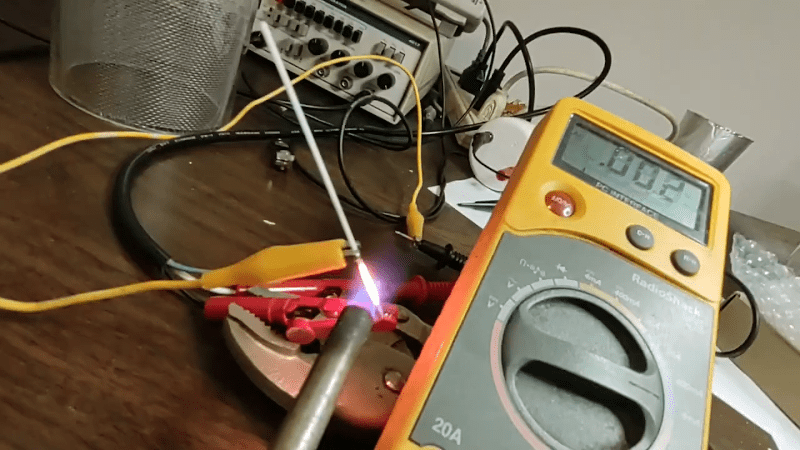Every biography of Edison talks about how the secret to the incandescent lamp was to remove the air from the bulb. That’s true when you use conventional filaments, but a man named Nernst found that using a filament that was already oxidized would allow you to create a lamp that would operate fine in the normal atmosphere. [Jaynes Network] takes a look at these oddities which date back to the 1800s in a recent video that you can see below.
The lamps use a ceramic filament, but the downside is that the filament needs to be hot to allow the lamp to work. The experiment takes a zirconium oxide rod and attempts to light it up. The heat source is a propane torch.
We don’t suggest hooking up alligator clips to an electric cord as you see in the video. A resistor, a fuse, and an isolation transformer would make the setup a little safer. If all this isn’t dangerous enough, don’t forget there’s also a flaming propane torch and burning insulation. What could go wrong?
It took a few attempts to get the rod to conduct more with heat, but finally, there was an increase in current. We’ll have to wait for the next installment to see if it really lights up or not.
The last lamp like this we saw used a ceramic knife blade as a filament. If you want more history of the Nernst, check out our Retrotechtacular.
















Do we as a community need to promote hoax and disinformation channels?
This guys channel has videos about “psychotronics”, “antigravity”, etc.
….
Yeah, I much prefer Photonicinduction’s recent video on these.
https://youtu.be/-spTvp5-sf0
(to help the curious)
Is religion a hoax too? Why not stop all ‘unproven’ ideas.
Seeds are planted and if not proven, ideas die. But to stiffle ideas seems just as backwards. We might have ideas that sometimes are incongruent, but why stop all sharing if one does not fit.
I think you might need to get the electrical contacts into the heated area. Maybe steel or carbon “brushes”.
I’ve seen similar with a glass rod and passing mains electricity through it.
I was going to say don’t try this at home, kids, but well, this IS hackaday!
Interesting that glass is seemingly very conducive when it’s in a molten state.
Although it makes sense, thinking about melting glass bottles in a microwave, after having applied heat with a blow torch. It would be interesting to see if it’s more efficient, to use electricity or rf, than coal for melting large quantities of glass.
A bit too close to the plastic insulation of the probe and clips… Must be nice to not having to care for your equipment.
Photonicinduction covers these nicely: https://youtu.be/-spTvp5-sf0
Tried to leave a link to Photonicinduction’s video about these lamps but just search his name on Youtube.
You wated to include this link? https://m.youtube.com/watch?v=-spTvp5-sf0
I envy his collection. I only have a single spark gap lamp from around 1890 for 1cm rods.
I love these lamp filaments,
despite the connection to a very dark and injust part of our planet’s history (in specific regions) that we must never repeat.
as for the danger: i would assume that the fact that fire conducts electricity to be the most worrying, then again, if the flame touches the neutral terminal more then the hot, it may form a potential-divider and only get 30 or 60 volts (assuming 120v supply) , which might be “almost-safe-enough” for standing on carpet or wearing shoes that are perfectly dry.
also, consider that radon (which goes through concrete ect just fine), decays into unstable lead… which conducts electricity far better then concrete alone… that may be why bare-foot on concrete is more dangerous then you might assume. so i would not do it with socks on concrete running on 240v, but i would do it with 120v and shoes, maybe a sheet of dry cardboard just in case.
using an isolation transformer would cure any risk, and would be the reccommended route, as long as theres no stray connections caused by carbonized wire insulation…
the only thing more dangerous then a heart-attack while unconciousss, is dropping a lit torch while unconciouss and having a heart-attack!
Imminent toasted meter.
This guy should not be allowed near open flames and wall power.